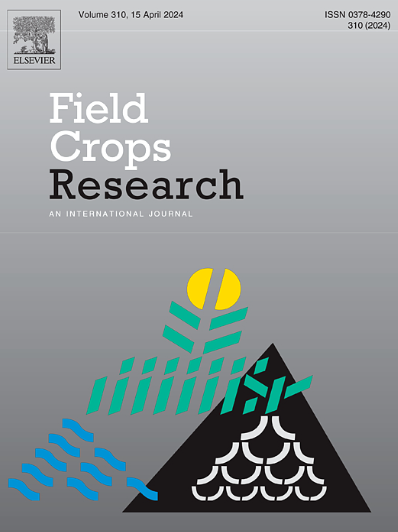Response of reactive nitrogen losses and nitrogen fate in the soil-crop system to intercropping regimes
IF 5.6
1区 农林科学
Q1 AGRONOMY
引用次数: 0
Abstract
Context
Reactive nitrogen (N) loss from cropping systems is strongly influenced by cultivation regimes and microbial activity involved in soil N cycling. Intercropping offers ecological benefits, including enhanced crop yield, improved soil fertility, and increased resource use efficiency, making it a promising strategy for achieving sustainable agriculture.
Research question
However, the complex interspecific interactions and rhizosphere networks in intercropping systems alter N cycling and losses, and the underlying driving factors remain unclear.
Methods
This study employed a meta-analytical approach and a linear mixed-effects model to assess the effects of intercropping on soil reactive N losses (N2O emissions, NH3 volatilisation, N leaching, and runoff) and N fate in soil-crop systems (using data from 15N tracer trials).
Results
The findings indicate that intercropping significantly reduced soil NH3 volatilisation, N leaching, and runoff while enhancing the recovery of N derived from fertilisers (Ndff) in soil compared to monoculture. The adoption of intercropping in regions with high mean annual precipitation (MAP > 800 mm) or mean annual temperature (MAT > 20 ℃) as well as in soils that are alkaline (pH > 8), low in soil organic carbon (SOC ≤ 10 g kg−1), or moderate in total N (1 < STN ≤ 1.5 g kg-¹), in conjunction with high N application rates (NAR > 200 Kg N ha-¹), resulted in relatively lower NH3 volatilisation, N leaching, and runoff compared to monoculture. Furthermore, cereal–legume intercropping was found to reduce N2O emissions. Intercropping in soils with low SOC and STN (STN ≤ 1 g kg−1) or using moderate N application (100 < NAR ≤ 200 Kg N ha−1) increased Ndff recovery in soil and the total soil-crop system.
Conclusions
Intercropping has substantial potential to reduce soil reactive N losses and enhance Ndff recovery in soil-crop systems. The selection of suitable intercropping types, N application rates, and soil conditions should be carefully considered to maximise its effectiveness.
Implications
These findings provide robust recommendations for the future adoption of intercropping practices, the mitigation of N pollution, and sustainable management of N in agricultural systems.
间作制度对土壤-作物系统活性氮损失和氮素命运的响应
耕作制度和参与土壤氮循环的微生物活动对作物系统的环境活性氮(N)损失有很大影响。间作具有生态效益,包括提高作物产量、改善土壤肥力和提高资源利用效率,使其成为实现可持续农业的一项有前景的战略。然而,间作系统中复杂的种间相互作用和根际网络改变了氮素的循环和损失,潜在的驱动因素尚不清楚。方法本研究采用元分析方法和线性混合效应模型,评估间作对土壤活性氮损失(N2O排放、NH3挥发、N淋溶和径流)和土壤-作物系统中N形态的影响(使用来自15N示踪试验的数据)。结果与单作相比,间作显著减少了土壤NH3挥发、氮淋溶和径流,同时提高了土壤中氮素的恢复。年平均降水量高的地区采用间作(MAP >;800 mm)或年平均温度(MAT >;20℃)以及碱性土壤(pH >;8)土壤有机碳低(SOC≤10 g kg−1)或全氮中等(1 <;STN≤1.5 g kg-¹),配合高施氮量(NAR >;200 Kg N ha- 1),与单一栽培相比,NH3挥发、N淋溶和径流相对较低。此外,谷类-豆科作物间作还能减少N2O的排放。低有机碳和STN (STN≤1 g kg−1)土壤间作或适度施氮(100 <;NAR≤200 Kg N ha−1)增加了土壤和整个土壤-作物系统的Ndff恢复。结论在土壤-作物系统中,种植具有减少土壤活性氮损失和促进Ndff恢复的潜力。应慎重选择适宜的间作类型、施氮量和土壤条件,使间作效果最大化。这些发现为未来采用间作、缓解氮污染和农业系统中氮的可持续管理提供了强有力的建议。
本文章由计算机程序翻译,如有差异,请以英文原文为准。
求助全文
约1分钟内获得全文
求助全文
来源期刊

Field Crops Research
农林科学-农艺学
CiteScore
9.60
自引率
12.10%
发文量
307
审稿时长
46 days
期刊介绍:
Field Crops Research is an international journal publishing scientific articles on:
√ experimental and modelling research at field, farm and landscape levels
on temperate and tropical crops and cropping systems,
with a focus on crop ecology and physiology, agronomy, and plant genetics and breeding.
 求助内容:
求助内容: 应助结果提醒方式:
应助结果提醒方式:


